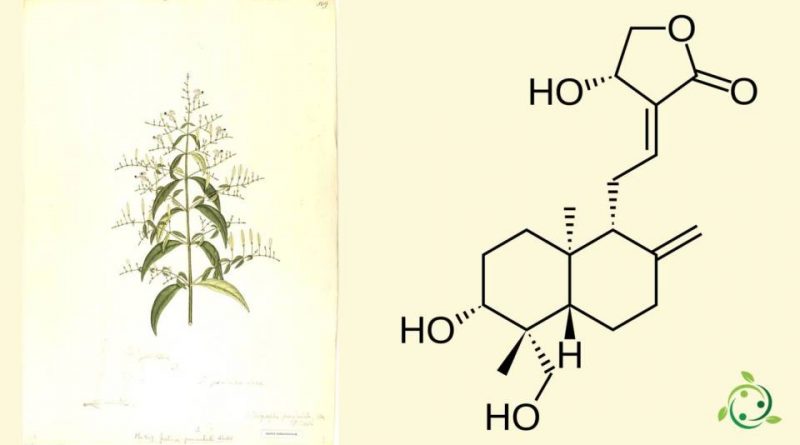Andrographolide
Andrographolide
Andrographolide, whose term in the official IUPAC nomenclature is: 3- [2- [Decahydro-6-hydroxy-5- (hydroxymethyl) -5.8a-dimethyl-2-methylene-1-naphthalenyl] ethylidene] dihydro-4 -hydroxy-2 (3H) -furanone is a diterpene lactone isolated from the stem and leaves of the Indian Echinacea (Andrographis paniculata (Burm.f.) Wall. ex Nees) an annual herbaceous plant of the Acanthaceae family, native ‘India and Sri Lanka.
Also called, this plant helped to eradicate the flu epidemics that broke out in India in 1919. In Chinese phytomedicine, Chuan Xin lian is prescribed against fever and respiratory tract infections. Andrographis is part of the Chinese Pharmacopoeia (1997 Ed.) And is currently used in Scandinavia to relieve common cold symptoms.
Andrographolide has a brute or molecular formula C20H30O5 and is an extremely bitter substance commonly used in Ayurvedic medicine to combat dysentery, hepatitis, herpes, skin infections and snake bites.
Andrographolide has been studied for its effects on cellular immunomodulation and stroke. The study showed that andrographolide can bind to a spectrum of protein targets including NF-κB and actin by covalent modification.
Andrographolide is extracted from the leaves of Andrographis paniculata. Andrographolide is a diterpene lactone, which has depigmenting and antioxidant properties, interesting in the cosmetic field.
Andrographolide inhibits melanogenesis through two mechanisms: inhibition of endothelin synthesis and the production of nitric oxide (NO).
Andrographolide inhibits the production of nitric oxide (NO), reducing the expression of the protein NO synthase.
Nitric oxide is known for its ability to modulate melanogenesis induced by UV rays. In fact, UV rays increase the production of nitric oxide by activating the NO synthase of keratinocytes. Nitric oxide is involved in the regulation network stimulated by UV rays, resulting in the stimulation of skin pigmentation. The inhibition of nitric oxide production by andrographolide thus allows to block melanogenesis.
Andrographolide inhibits the synthesis of endothelin.
Endothelin is an intrinsic mediator for human melanocytes, as it is involved in UV-induced pigmentation. Keratinocytes are known to produce various factors constitutively, including endothelin-1 (ET-1), which affect the proliferation and migration of melanocytes, as well as melanogenesis. Following exposure to UV rays, the synthesis and secretion of ET-1 are regulated in the keratinocytes. Andrographis paniculata extracts (0.01% to 0.1%) block the synthesis of endothelin, thus inhibiting its action on the proliferation and migration of melanocytes, as well as on melanogenesis.
Warning: The information shown is not medical advice and may not be accurate. The contents are for illustrative purposes only and do not replace medical advice.

